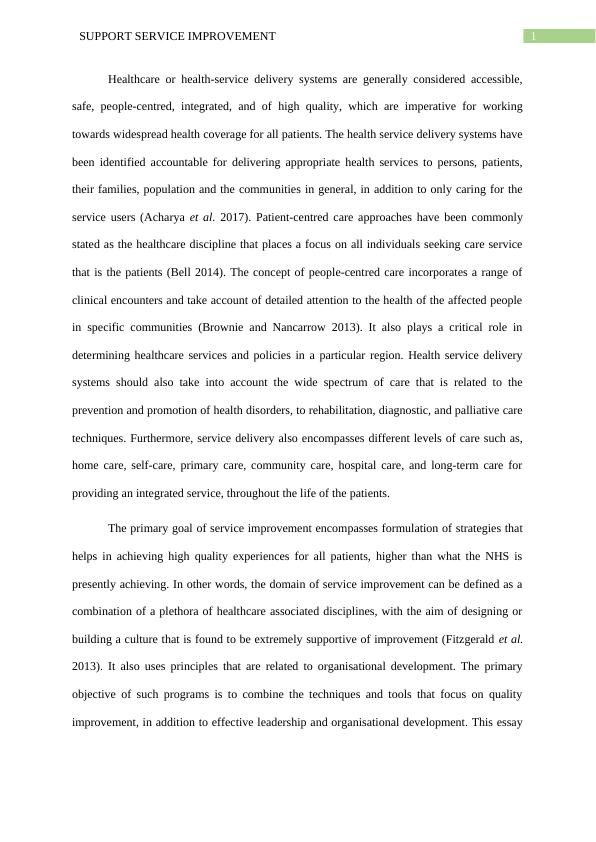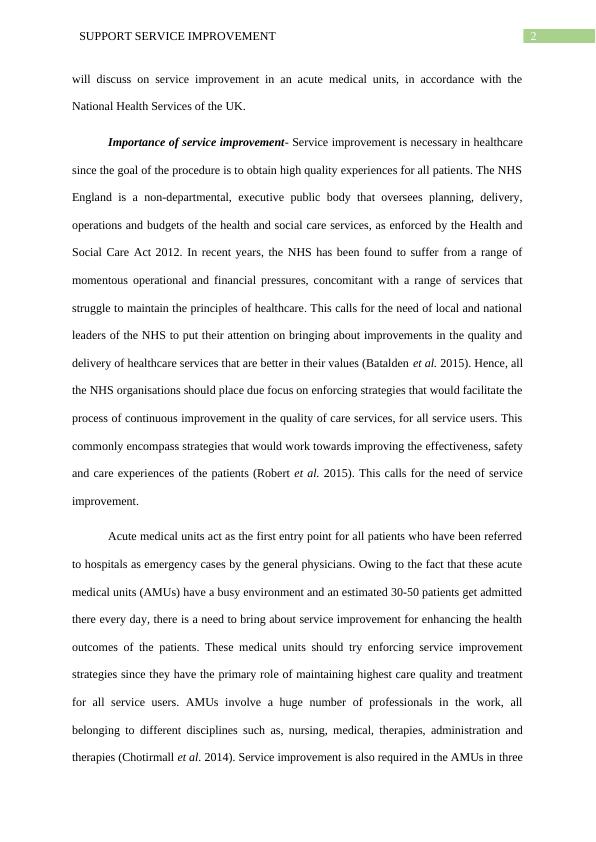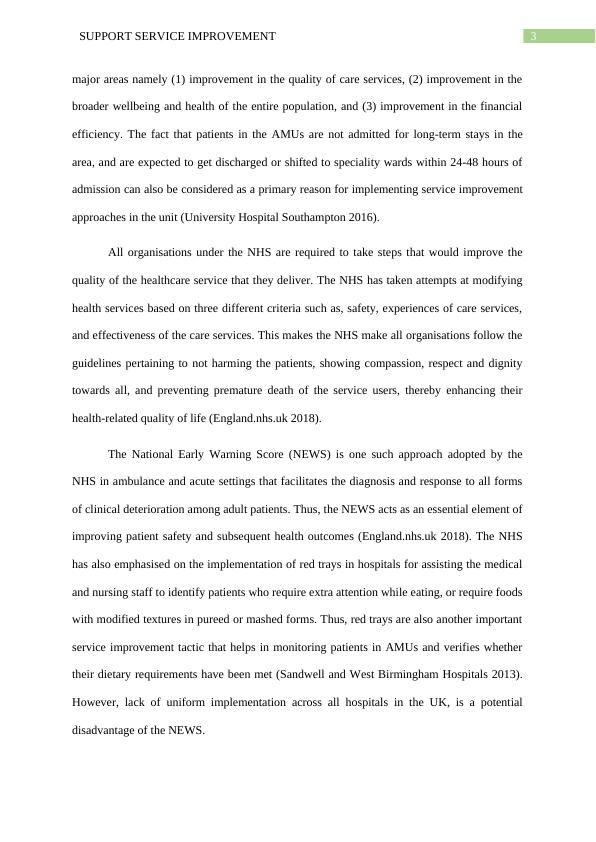Service Improvement in Acute Medical Units: Importance and Suggestions
Added on 2023-06-09
16 Pages4996 Words417 Views
Running head: SUPPORTING SERVICE IMPROVEMENT
Essay
Name of the Student
Name of the University
Author Note
Essay
Name of the Student
Name of the University
Author Note

1SUPPORT SERVICE IMPROVEMENT
Healthcare or health-service delivery systems are generally considered accessible,
safe, people-centred, integrated, and of high quality, which are imperative for working
towards widespread health coverage for all patients. The health service delivery systems have
been identified accountable for delivering appropriate health services to persons, patients,
their families, population and the communities in general, in addition to only caring for the
service users (Acharya et al. 2017). Patient-centred care approaches have been commonly
stated as the healthcare discipline that places a focus on all individuals seeking care service
that is the patients (Bell 2014). The concept of people-centred care incorporates a range of
clinical encounters and take account of detailed attention to the health of the affected people
in specific communities (Brownie and Nancarrow 2013). It also plays a critical role in
determining healthcare services and policies in a particular region. Health service delivery
systems should also take into account the wide spectrum of care that is related to the
prevention and promotion of health disorders, to rehabilitation, diagnostic, and palliative care
techniques. Furthermore, service delivery also encompasses different levels of care such as,
home care, self-care, primary care, community care, hospital care, and long-term care for
providing an integrated service, throughout the life of the patients.
The primary goal of service improvement encompasses formulation of strategies that
helps in achieving high quality experiences for all patients, higher than what the NHS is
presently achieving. In other words, the domain of service improvement can be defined as a
combination of a plethora of healthcare associated disciplines, with the aim of designing or
building a culture that is found to be extremely supportive of improvement (Fitzgerald et al.
2013). It also uses principles that are related to organisational development. The primary
objective of such programs is to combine the techniques and tools that focus on quality
improvement, in addition to effective leadership and organisational development. This essay
Healthcare or health-service delivery systems are generally considered accessible,
safe, people-centred, integrated, and of high quality, which are imperative for working
towards widespread health coverage for all patients. The health service delivery systems have
been identified accountable for delivering appropriate health services to persons, patients,
their families, population and the communities in general, in addition to only caring for the
service users (Acharya et al. 2017). Patient-centred care approaches have been commonly
stated as the healthcare discipline that places a focus on all individuals seeking care service
that is the patients (Bell 2014). The concept of people-centred care incorporates a range of
clinical encounters and take account of detailed attention to the health of the affected people
in specific communities (Brownie and Nancarrow 2013). It also plays a critical role in
determining healthcare services and policies in a particular region. Health service delivery
systems should also take into account the wide spectrum of care that is related to the
prevention and promotion of health disorders, to rehabilitation, diagnostic, and palliative care
techniques. Furthermore, service delivery also encompasses different levels of care such as,
home care, self-care, primary care, community care, hospital care, and long-term care for
providing an integrated service, throughout the life of the patients.
The primary goal of service improvement encompasses formulation of strategies that
helps in achieving high quality experiences for all patients, higher than what the NHS is
presently achieving. In other words, the domain of service improvement can be defined as a
combination of a plethora of healthcare associated disciplines, with the aim of designing or
building a culture that is found to be extremely supportive of improvement (Fitzgerald et al.
2013). It also uses principles that are related to organisational development. The primary
objective of such programs is to combine the techniques and tools that focus on quality
improvement, in addition to effective leadership and organisational development. This essay

2SUPPORT SERVICE IMPROVEMENT
will discuss on service improvement in an acute medical units, in accordance with the
National Health Services of the UK.
Importance of service improvement- Service improvement is necessary in healthcare
since the goal of the procedure is to obtain high quality experiences for all patients. The NHS
England is a non-departmental, executive public body that oversees planning, delivery,
operations and budgets of the health and social care services, as enforced by the Health and
Social Care Act 2012. In recent years, the NHS has been found to suffer from a range of
momentous operational and financial pressures, concomitant with a range of services that
struggle to maintain the principles of healthcare. This calls for the need of local and national
leaders of the NHS to put their attention on bringing about improvements in the quality and
delivery of healthcare services that are better in their values (Batalden et al. 2015). Hence, all
the NHS organisations should place due focus on enforcing strategies that would facilitate the
process of continuous improvement in the quality of care services, for all service users. This
commonly encompass strategies that would work towards improving the effectiveness, safety
and care experiences of the patients (Robert et al. 2015). This calls for the need of service
improvement.
Acute medical units act as the first entry point for all patients who have been referred
to hospitals as emergency cases by the general physicians. Owing to the fact that these acute
medical units (AMUs) have a busy environment and an estimated 30-50 patients get admitted
there every day, there is a need to bring about service improvement for enhancing the health
outcomes of the patients. These medical units should try enforcing service improvement
strategies since they have the primary role of maintaining highest care quality and treatment
for all service users. AMUs involve a huge number of professionals in the work, all
belonging to different disciplines such as, nursing, medical, therapies, administration and
therapies (Chotirmall et al. 2014). Service improvement is also required in the AMUs in three
will discuss on service improvement in an acute medical units, in accordance with the
National Health Services of the UK.
Importance of service improvement- Service improvement is necessary in healthcare
since the goal of the procedure is to obtain high quality experiences for all patients. The NHS
England is a non-departmental, executive public body that oversees planning, delivery,
operations and budgets of the health and social care services, as enforced by the Health and
Social Care Act 2012. In recent years, the NHS has been found to suffer from a range of
momentous operational and financial pressures, concomitant with a range of services that
struggle to maintain the principles of healthcare. This calls for the need of local and national
leaders of the NHS to put their attention on bringing about improvements in the quality and
delivery of healthcare services that are better in their values (Batalden et al. 2015). Hence, all
the NHS organisations should place due focus on enforcing strategies that would facilitate the
process of continuous improvement in the quality of care services, for all service users. This
commonly encompass strategies that would work towards improving the effectiveness, safety
and care experiences of the patients (Robert et al. 2015). This calls for the need of service
improvement.
Acute medical units act as the first entry point for all patients who have been referred
to hospitals as emergency cases by the general physicians. Owing to the fact that these acute
medical units (AMUs) have a busy environment and an estimated 30-50 patients get admitted
there every day, there is a need to bring about service improvement for enhancing the health
outcomes of the patients. These medical units should try enforcing service improvement
strategies since they have the primary role of maintaining highest care quality and treatment
for all service users. AMUs involve a huge number of professionals in the work, all
belonging to different disciplines such as, nursing, medical, therapies, administration and
therapies (Chotirmall et al. 2014). Service improvement is also required in the AMUs in three

3SUPPORT SERVICE IMPROVEMENT
major areas namely (1) improvement in the quality of care services, (2) improvement in the
broader wellbeing and health of the entire population, and (3) improvement in the financial
efficiency. The fact that patients in the AMUs are not admitted for long-term stays in the
area, and are expected to get discharged or shifted to speciality wards within 24-48 hours of
admission can also be considered as a primary reason for implementing service improvement
approaches in the unit (University Hospital Southampton 2016).
All organisations under the NHS are required to take steps that would improve the
quality of the healthcare service that they deliver. The NHS has taken attempts at modifying
health services based on three different criteria such as, safety, experiences of care services,
and effectiveness of the care services. This makes the NHS make all organisations follow the
guidelines pertaining to not harming the patients, showing compassion, respect and dignity
towards all, and preventing premature death of the service users, thereby enhancing their
health-related quality of life (England.nhs.uk 2018).
The National Early Warning Score (NEWS) is one such approach adopted by the
NHS in ambulance and acute settings that facilitates the diagnosis and response to all forms
of clinical deterioration among adult patients. Thus, the NEWS acts as an essential element of
improving patient safety and subsequent health outcomes (England.nhs.uk 2018). The NHS
has also emphasised on the implementation of red trays in hospitals for assisting the medical
and nursing staff to identify patients who require extra attention while eating, or require foods
with modified textures in pureed or mashed forms. Thus, red trays are also another important
service improvement tactic that helps in monitoring patients in AMUs and verifies whether
their dietary requirements have been met (Sandwell and West Birmingham Hospitals 2013).
However, lack of uniform implementation across all hospitals in the UK, is a potential
disadvantage of the NEWS.
major areas namely (1) improvement in the quality of care services, (2) improvement in the
broader wellbeing and health of the entire population, and (3) improvement in the financial
efficiency. The fact that patients in the AMUs are not admitted for long-term stays in the
area, and are expected to get discharged or shifted to speciality wards within 24-48 hours of
admission can also be considered as a primary reason for implementing service improvement
approaches in the unit (University Hospital Southampton 2016).
All organisations under the NHS are required to take steps that would improve the
quality of the healthcare service that they deliver. The NHS has taken attempts at modifying
health services based on three different criteria such as, safety, experiences of care services,
and effectiveness of the care services. This makes the NHS make all organisations follow the
guidelines pertaining to not harming the patients, showing compassion, respect and dignity
towards all, and preventing premature death of the service users, thereby enhancing their
health-related quality of life (England.nhs.uk 2018).
The National Early Warning Score (NEWS) is one such approach adopted by the
NHS in ambulance and acute settings that facilitates the diagnosis and response to all forms
of clinical deterioration among adult patients. Thus, the NEWS acts as an essential element of
improving patient safety and subsequent health outcomes (England.nhs.uk 2018). The NHS
has also emphasised on the implementation of red trays in hospitals for assisting the medical
and nursing staff to identify patients who require extra attention while eating, or require foods
with modified textures in pureed or mashed forms. Thus, red trays are also another important
service improvement tactic that helps in monitoring patients in AMUs and verifies whether
their dietary requirements have been met (Sandwell and West Birmingham Hospitals 2013).
However, lack of uniform implementation across all hospitals in the UK, is a potential
disadvantage of the NEWS.

End of preview
Want to access all the pages? Upload your documents or become a member.
Related Documents
Legal and Ethical Issues in Accountability in Health and Social Carelg...
|8
|2414
|475
Role of Nursing Professionals | Essaylg...
|10
|2768
|24
Person-Centric Care: Competence and Professionalism in Nursinglg...
|7
|2200
|163
Contribution to and Impact of Nursing and Midwifery Practice on Patient Safety Agendalg...
|18
|5547
|281
Hospital Information Systems (HIS) - Assignmentlg...
|12
|3973
|105
Health and social care servicelg...
|8
|1631
|55